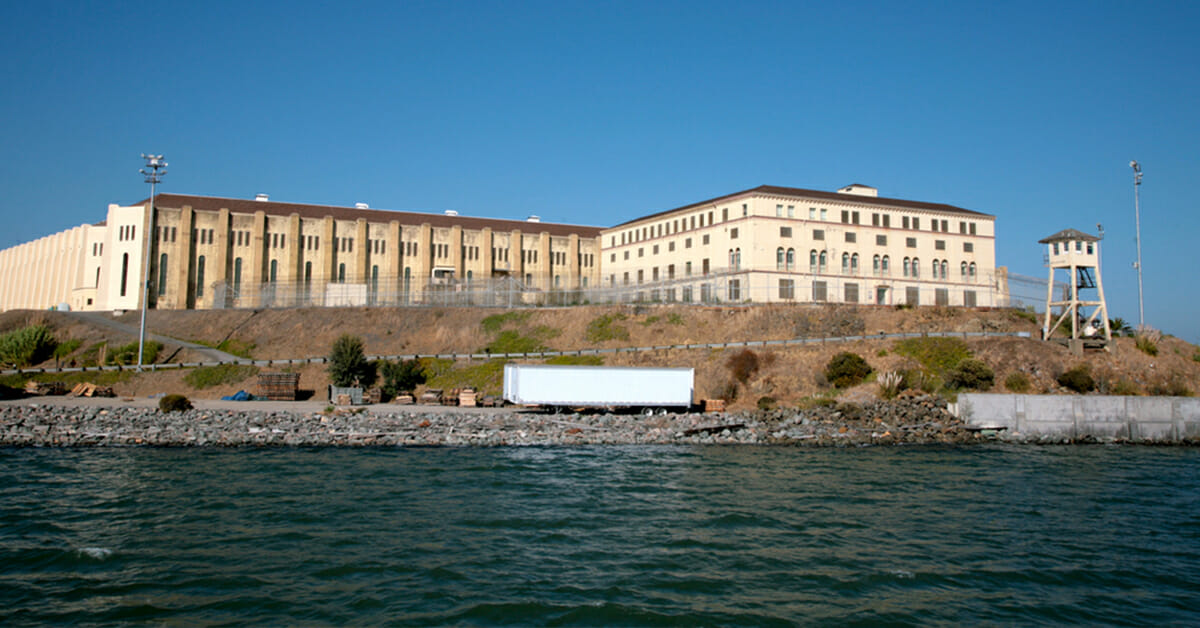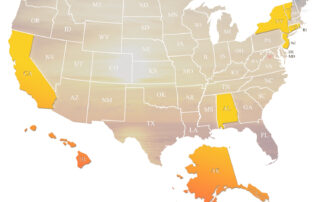
Criminal Justice in California
The State of California is home to almost 40 million people, per the 2020 Census. With 12% of the U.S. population residing within California’s borders, it’s no surprise the state’s criminal justice system has many complex branches, governing bodies, lawmaking institutions, reform groups, and data-gathering think tanks. The following is a brief presentation of results, findings, statistics, successful strategies, and areas where improvement is needed within California’s prison and criminal justice institutions.
California Prison Population Statistics
California ranks 32nd in the nation for its incarceration rate, ahead of Maryland but behind North Carolina.1 From 2019 National Institute of Corrections data, there are 122,417 individuals incarcerated in prisons in California.2 Another 82,460 are in jail, 107,139 are on parole, and 199,313 are on probation. More than half a million Californians, or one out of every 80 residents, are (or were) involved in the criminal justice system. While the state does not have a particularly high incarceration-per-capita rate, the state’s current and former prison population dwarf all other U.S. states except Texas.
The 2019 National Institute of Corrections data also lists information on California’s prisons. The state has 33 prisons and 114 jails. The state is also home to 13 federal prisons and 8 federal prison camps. The federal prisons house an additional 11,235 inmates, prisoners who are serving sentences for federal crimes, not state-prosecuted crimes. The state of California also leases and operates one prison facility owned by a private company. The largest prison in California by population is the San Quentin State Prison, which houses 3,082 inmates. However, Valley State Prison has the highest overcrowding rate, with its incarcerated population currently at 150% of the prison’s design capacity.3

San Quentin State Prison
California’s prison system and criminal justice system are a massive network of institutions. It employs approximately 60,000 people, or 3 out of every 100 full-time workers in the state, and it has an annual budget of $15.7 billion, or 7% of the state’s total annual budget.4 The Department of Corrections is California’s 7th costliest budget item.5
California’s prison system and criminal justice system are a massive network of institutions. It employs approximately 60,000 people, or 3 out of every 100 full-time workers in the state, and it has an annual budget of $15.7 billion, or 7% of the state’s total annual budget.4 The Department of Corrections is California’s 7th costliest budget item.5
Crime and Recidivism in California
California has an incarceration rate of 301 individuals serving time in prison or jail for every 100,000 people living in the state. California’s violent crime rate is 441 per 100,000, and its property crime rate is 2,331 per 100,000.
According to the Bureau of Justice Assistance (an office within the U.S. Department of Justice), approximately 150,000-170,000 violent crimes are committed in California in any given year. Such crimes include aggravated assault, robbery, rape, murder, and manslaughter. California also records about 1.0–1.1 million property crimes yearly, including motor vehicle theft, larceny, and burglary. California law enforcement officers perform about 1.2 million arrests per year.6
One of the most significant challenges facing California is its high recidivism rate. BJA reports that about 61% of those incarcerated in California’s prison system will commit another offense and end up in prison again within three years of release. That means California’s prison system is not working for more than half of those who go through it.
The 61% recidivism rate is especially concerning, given that research from the University of California Berkeley reports that California is 2nd in the nation for per capita spending on corrections, 6th in the nation for per capita spending on prisoners, and 2nd in the nation for annual mean wages for correctional officers and jailers.7
In a nutshell, California is spending a great deal of money on its prison systems and criminal justice institutions, the state is investing in alternatives and innovative reform programs, yet the state still struggles with a more than 60% recidivism rate.
Rehabilitating Criminals in California

What will it take to rehabilitate criminals in California and reduce recidivism? Some efforts are beginning to show results, though improvement is slow-going and limited.
Criminal reform in California often works when individuals arrested for nonviolent drug possession crimes are directed into drug court (rather than made to serve time in prison). California operates 226 drug courts, the most drug courts of any state in the nation. Drug courts present nonviolent drug offenders with the opportunity to resolve their cases outside the traditional criminal justice system. They do this by directing offenders into drug rehab programs rather than the carceral network.8
Criminal rehabilitation in California works best when education programs inside prisons in California are made available to all inmates. While California has experienced a drop in prison population and crime rates, the state still needs to invest in educational and rehabilitative programs to ensure recidivism rates come down.9
A Need for Alternatives to Incarceration in California
California has been working to change its sentencing laws and implement alternatives to incarceration. In 2014, California passed Proposition 47, a monumental criminal justice reform measure. The California Courts office described the measure best: “First, it reclassified certain theft and drug possession offenses from felonies to misdemeanors. Second, it authorizes defendants serving sentences for felony offenses that would have qualified as misdemeanors under the proposition to petition courts for re-sentencing under the new misdemeanor provisions. Third, it authorizes defendants who have completed their sentences for felony convictions that would have qualified as misdemeanors under the proposition to apply to reclassify those convictions to misdemeanors.” That office went on to point out how, in the first 13 months after Prop 47 passed, California courts received more than 200,000 petitions from inmates for re-sentencing under the new standard.10
“First, it reclassified certain theft and drug possession offenses from felonies to misdemeanors…”
Proposition 57, a ballot measure passed in 2016, accomplished similar objectives, i.e., reducing prison overcrowding by letting nonviolent offenders seek parole sooner and offering credits for good behavior and participation in rehabilitation programs.11
Despite significant investment in reform efforts, reducing prison sentences, reducing prison overcrowding, and perhaps most notably the January 1st, 2021, Senate Bill 73 formally ending mandatory minimum sentencing for nonviolent drug crimes, California still struggles with a high recidivism rate.12
One could argue that this is because educational programs inside prisons in California are too few and far between, and rehabilitation programs inside prisons in California struggle with providing adequate services to every inmate. California prisons need more access to a variety of reform modalities, and programs that need to be made available to all inmates.
Reform is Possible
Reform is possible. Many groups are working within prisons and correctional institutions all across America that seek to reduce recidivism and ensure inmates receive actual rehabilitation. California policymakers should invest renewed effort into ensuring inmates get the rehabilitation they need to lead lawful and productive lives post-release.
Sources:
- BJS. “Prisoners in 2020 – Statistical Tables.” Bureau of Justice Statistics, 2021. bjs.ojp.gov
- NIC. “California 2019.” National Institute of Corrections, 2019. nicic.gov
- LAO. “Effectively Managing State Prison Infrastructure.” Legislative Analyst’s Office, 2020. lao.ca.gov
- State Budget. “Enacted Budget Detail.” California’s 2019-2020 State Budget, 2019. ebudget.ca.gov
- Urban. “Project California.” Urban Institute, 2022. urban.org
- BJA. “State Criminal Justice Profile: California.” Bureau of Justice Assistance, 2014. bjafactsheets.iir.com
- Berkeley. “How Does California’s Criminal Justice System Compare to Other States?” Berkeley Law, 2012. law.berkeley.edu
- California Courts. “Drug Courts.” California Courts, 2022. courts.ca.gov
- CalBudgetCenter. “Criminal Justice Reform Is Working in California.” California Budget & Policy Center, 2020. calbudgetcenter.org
- California Courts. “Proposition 47: The Safe Neighborhoods and Schools Act.” California Courts, 2014. courts.ca.gov
- California Courts. “Proposition 57” California Courts, 2016. courts.ca.gov
- CA Senate. “Governor Newsom Signs Into Law Senator Wiener’s Legislation to End Mandatory Minimum Sentences for Nonviolent Drug Crimes.” Scott Wiener, Representing Senate District II, 2020. sd11.senate.ca.gov
Related Articles
Education Is a Key Factor in Reducing Offender Recidivism
Research shows that providing inmates with educational services furnishes them with the tools they need to lead happy, successful, productive, and crime-free lives. State and...
Read more >>
The Importance of Education for Prisoners
Incarcerated individuals who pursue educational opportunities while incarcerated set themselves up for a better life once released. As the U.S. prison population remains the highest...
Read more >>
Criminal Justice Reform Extends Rights to Felons Who Have Served Their Sentences
For decades, voter enfranchisement or disenfranchisement for incarcerated and formerly incarcerated individuals has been debated. An estimated 4.6 million Americans are barred from voting due...
Read more >>
Nine States Have Reduced Their Prisoner Population by 30%. What Do They Have in Common?
For the first time in decades, several U.S. states are making a concerted effort to reduce their prison populations by applying a range of policy...
Read more >>





